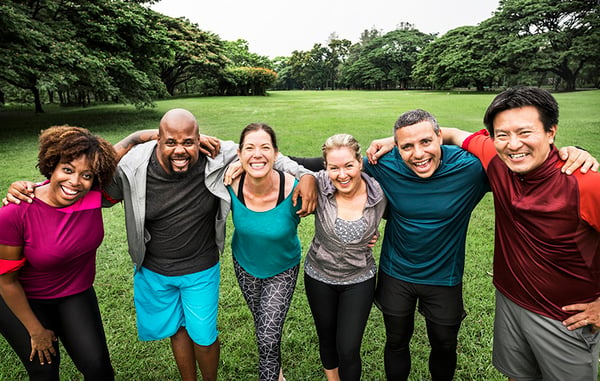
Fitness professionals lead the charge with coaching and mentoring individuals towards their goals and better their overall health.
As leaders in our industry, instructors, and trainers have a responsibility to understand how Diversity, Equity, and Inclusion topics impact individuals who occupy fitness spaces (online and offline) to enhance an environment’s welcoming atmosphere.
What do Diversity, Equity, and Inclusion mean?
Diversity: Opening up access to a variety of folks
Equity: Keeping the field and making the field level and fair
Inclusion: Ensuring that our variety of folks belong and that their unique differences are appreciated
Why Focus on Diversity, Equity, and Inclusion in Fitness?
• Certain social factors are determinants of health, such as poverty, childhood upbringing, food security, poor health conditions, and accessibility.
• Social issues such as racism have created a burden for many individuals in this country, leading to chronic physical and mental illness.
• Biases that ostracize groups of individuals create feelings of exclusion, especially in the wellness and fitness space.
The work truly begins with breaking down biases. All good people have subconscious and conscious tendencies and opinions that impact the decisions they make. Biases are purely preferences or opinions we can have about various groups of people we are more like or are more dissimilar from. It’s up to our collective group of fitness professionals to understand the process of biases being created and then adjust our thinking accordingly to remain inclusive.
Diversity: Embracing a variety of individuals.
The primary way to increase diversity as a fitness professional is to start by looking at the variety of your immediate circle of influence, and then expand your circle:
Add in more variety:
- Learn from those most different from you to ensure that your circle of influence is diverse.
- As a result, your thoughts and empathy levels shift.
- You defend and stand up for who is part of your in-group.
Equity: Leveling the playing field.
As a society, we have to look at how we're equitable to realize just how impactful imbalances affect those in the fitness space. If all individuals aren’t able to access a fitness facility due to price, it could have an impact on why there may be higher health risks and issues in any given community where they live? Our goal is to maintain profitable businesses to make a living while being creative with options for those we aim to serve.
Adjusting pricing to allow flexibility and reaching into communities that we may not otherwise serve are two ways to do just that. Donation-only classes, donation-optionable workshops, and scholarships to have members help a community access wellness are unique new ways fitness professionals can seek more equitable solutions in their work.
Inclusion: Ensuring a sense of belonging.
Conquering our internal biases allows us to get away from societal and social “norms” that have been driven into our heads to classify individuals we come into contact with or may not understand a lot about. Differences make us unique and give us ways to learn about one another instead of derision or judgment based on them.
How can we create environments that foster belonging? We can make sure all individuals are welcome, no matter their shape, shade, and size. We can make fitness and wellness spaces less about performative goals and milestones and more about unification and community wholeness. We can lookout for one another and take time to empathize with others around us genuinely.
Refer to this post for more helpful content around Diversity in Fitness:
https://blog.afaa.com/why-diversity-matters-to-our-participants
Focus on Being a Good Leader in the Fitness Industry through DEI:
All in all, taking the time to understand the impact one has as a fitness leader and how working through ways to enhance diversification of one's circles of influence starts the process for more diversity as a fitness professional. Diversification leads to mutual understanding, which leads to empathy. To make spaces more inclusive and equitable, we have to understand how empathy allows us to take a seat in the shoes of clients and students we want to lead to positively affect their lives.
Resources:
1. Banaji, M. R., & Greenwald, A. G. (2013). Blindspot: Hidden biases of good people. New York: Delacorte Press.
2. Fontana, F., Bopes, J., Bendixen, S., Speed, T., George, M., & Mack, M. (2018, May 01). Discrimination against Obese Exercise Clients: An Experimental Study of Personal Trainers. Retrieved from https://www.ncbi.nlm.nih.gov/pmc/articles/PMC5955305/
3. Human Genome (Human Genome Project). (2013). Encyclopedia of Neuroscience, 1873-1873. doi:10.1007/978-3-540-29678-2_2265
4. Nyborg, H. (2019). Race as a Social Construct. Psych, 1(1), 139-165. doi:10.3390/psych1010011
5. Chou, V. (2017, April 17). How Science and Genetics are Reshaping the Race Debate of the 21st Century. Retrieved September 2, 2020, from http://sitn.hms.harvard.edu/flash/2017/science-genetics-reshaping-race-debate-21st-century/
6. Taylor, — J., Jamila Taylor Director of Health Care Reform and Senior Fellow, Taylor, J., Director of Health Care Reform and Senior Fellow, Kaverman, — B., — By Andrew Stettner and Michele Evermore, . . . Kahlenberg, — B. (2020, May 07). Racism, Inequality, and Health Care for African Americans. Retrieved from https://tcf.org/content/report/racism-inequality-health-care-african-americans/?session=1
7. Cardinal, B. J., Whitney, A. R., Narimatsu, M., Hubert, N., & Souza, B. J. (2014). Obesity Bias in the Gym: An Under-recognized Social Justice, Diversity, and Inclusivity Issue. Journal of Physical Education, Recreation & Dance, 85(6), 3-6. doi:10.1080/07303084.2014.927668
8. Fontana, F., Bopes, J., Bendixen, S., Speed, T., George, M., & Mack, M. (2018, May 01). Discrimination against Obese Exercise Clients: An Experimental Study of Personal Trainers. Retrieved from https://www.ncbi.nlm.nih.gov/pmc/articles/PMC5955305/


